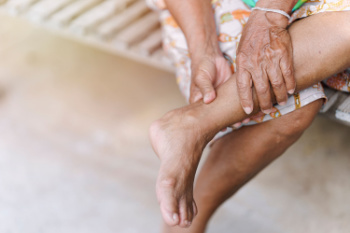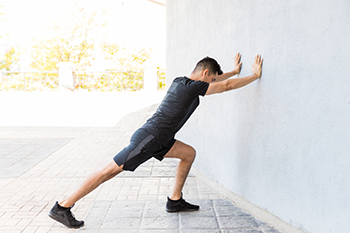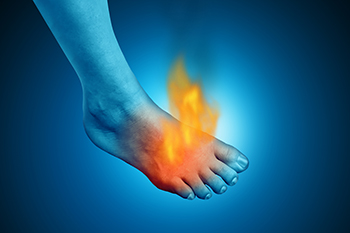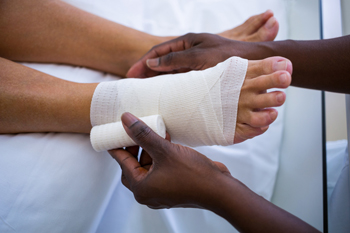Connect With Us
Blog
Items filtered by date: February 2024
Why Regular Foot Check-Ups Are Important for Older Adults
 Regular foot check-ups are important for older adults to help identify potential problems early on. Getting treatment for any issues also prevents these problems from escalating into more serious conditions. As people age, changes in foot structure, skin integrity, and circulation can occur, making the feet more susceptible to various issues, such as pain and cracked heels. Regular check-ups become especially important for those with chronic conditions like diabetes or arthritis, as these can significantly impact foot health. Certain conditions, like plantar fasciitis and osteoarthritis, become more likely with repetitive movement and the natural wear and tear that comes with aging. Podiatrists can assess the risk of developing complications, provide personalized advice on footwear, and offer guidance on preventive measures. If you have concerns about your foot health as an older adult, or if you are experiencing foot pain, it is suggested that you schedule an appointment with a podiatrist.
Regular foot check-ups are important for older adults to help identify potential problems early on. Getting treatment for any issues also prevents these problems from escalating into more serious conditions. As people age, changes in foot structure, skin integrity, and circulation can occur, making the feet more susceptible to various issues, such as pain and cracked heels. Regular check-ups become especially important for those with chronic conditions like diabetes or arthritis, as these can significantly impact foot health. Certain conditions, like plantar fasciitis and osteoarthritis, become more likely with repetitive movement and the natural wear and tear that comes with aging. Podiatrists can assess the risk of developing complications, provide personalized advice on footwear, and offer guidance on preventive measures. If you have concerns about your foot health as an older adult, or if you are experiencing foot pain, it is suggested that you schedule an appointment with a podiatrist.
If you need your feet checked, contact Ronald Pieroni, DPM of Bolingbrook Foot and Ankle Center. Our doctor will attend to all of your foot and ankle needs and provide you with quality treatment.
Geriatrics and Podiatry
When people age, some common issues that may occur are bone density loss, dry skin, poor circulation, and rough brittle nails. These issues may also affect your foot health if the necessary steps are not taken to alleviate the problems.
It is important to take care of your feet because feet that are injured or diseased can affect your overall health. Having painful feet hinders your ability to do daily activities or may decrease your willingness to do the things that you need to do.
Visiting Your Geriatrician
As we age, health problems become more likely, so it is essential to visit your doctor for check-ups to ensure that you are doing the best you can to take care of your health. It is recommended to check your feet frequently for any possible cuts, bruises, swelling, corns or any other irregularities.
Taking Care of Elderly Feet
Cracked or dry feet can be treated by applying moisturizer often. It is also important not to wear old socks because the older the sock is, the higher the possibility there will be that there is bacteria there. Wear fresh socks and make sure they fit properly.
Proper foot health means that you can have a more active lifestyle and you will not be bogged down by pain. Foot health also leads to good circulation, which is paramount for overall health.
If you have any questions, please feel free to contact our office located in Bolingbrook, IL . We offer the newest diagnostic tools and technology to treat your foot and ankle needs.
The Importance of Achilles Tendon Stretching Post-Injury

Stretching the Achilles tendon after an injury is paramount for facilitating recovery, restoring flexibility, and preventing future issues. Whether from overuse, strain, or rupture, Achilles tendon injuries can be debilitating, impacting mobility and quality of life. Gentle stretching exercises play an essential role in promoting healing and preventing stiffness, which can hinder rehabilitation progress. Simple stretches, such as calf raises, wall stretches, and towel stretches, help elongate the Achilles tendon and calf muscles, reducing tension and promoting blood flow to the injured area. It is essential to approach stretching with caution, starting gradually and avoiding overexertion to prevent further damage. Consistency is key, as regular stretching sessions can gradually improve flexibility and range of motion in the Achilles tendon and surrounding muscles. Incorporating stretching exercises into a comprehensive rehabilitation program, under the guidance of a podiatrist, can accelerate recovery and minimize the risk of reinjury. If you have endured an Achilles tendon injury, it is suggested that you speak with a podiatrist who can guide you toward stretches that are correct for you.
Achilles tendon injuries need immediate attention to avoid future complications. If you have any concerns, contact Ronald Pieroni, DPM of Bolingbrook Foot and Ankle Center. Our doctor can provide the care you need to keep you pain-free and on your feet.
What Is the Achilles Tendon?
The Achilles tendon is a tendon that connects the lower leg muscles and calf to the heel of the foot. It is the strongest tendon in the human body and is essential for making movement possible. Because this tendon is such an integral part of the body, any injuries to it can create immense difficulties and should immediately be presented to a doctor.
What Are the Symptoms of an Achilles Tendon Injury?
There are various types of injuries that can affect the Achilles tendon. The two most common injuries are Achilles tendinitis and ruptures of the tendon.
Achilles Tendinitis Symptoms
- Inflammation
- Dull to severe pain
- Increased blood flow to the tendon
- Thickening of the tendon
Rupture Symptoms
- Extreme pain and swelling in the foot
- Total immobility
Treatment and Prevention
Achilles tendon injuries are diagnosed by a thorough physical evaluation, which can include an MRI. Treatment involves rest, physical therapy, and in some cases, surgery. However, various preventative measures can be taken to avoid these injuries, such as:
- Thorough stretching of the tendon before and after exercise
- Strengthening exercises like calf raises, squats, leg curls, leg extensions, leg raises, lunges, and leg presses
If you have any questions please feel free to contact our office located in Bolingbrook, IL . We offer the newest diagnostic tools and technology to treat your foot and ankle needs.
Get Professional Care for a Broken Foot or Ankle
Burning Foot Pain May Signal Morton’s Neuroma

If you've been experiencing a burning sensation in your feet that extends into your toes, it could be a sign of Morton's neuroma. This is a condition characterized by a fibrous enlargement of the plantar nerve in the forefoot, most commonly the area between your third and fourth toes. It is often caused by compression from tight shoes, and women who wear high heels are particularly susceptible to Morton’s neuroma. The compression from footwear leads to inflammation and discomfort, which is made worse during activities like running or walking. A podiatrist can conduct an examination of your feet to determine whether you have Morton’s neuroma. Diagnosis typically involves ultrasound imaging to locate the neuroma, followed by cortisone injections to reduce inflammation, with surgery reserved for severe cases due to the risk of complications. With proper treatment, you can find relief from the discomfort and get back to enjoying your activities. If you believe you may have Morton’s neuroma, it is suggested that you make an appointment with a podiatrist.
Morton’s neuroma is a very uncomfortable condition to live with. If you think you have Morton’s neuroma, contact Ronald Pieroni, DPM of Bolingbrook Foot and Ankle Center. Our doctor will attend to all of your foot care needs and answer any of your related questions.
Morton’s Neuroma
Morton's neuroma is a painful foot condition that commonly affects the areas between the second and third or third and fourth toe, although other areas of the foot are also susceptible. Morton’s neuroma is caused by an inflamed nerve in the foot that is being squeezed and aggravated by surrounding bones.
What Increases the Chances of Having Morton’s Neuroma?
- Ill-fitting high heels or shoes that add pressure to the toe or foot
- Jogging, running or any sport that involves constant impact to the foot
- Flat feet, bunions, and any other foot deformities
Morton’s neuroma is a very treatable condition. Orthotics and shoe inserts can often be used to alleviate the pain on the forefront of the feet. In more severe cases, corticosteroids can also be prescribed. In order to figure out the best treatment for your neuroma, it’s recommended to seek the care of a podiatrist who can diagnose your condition and provide different treatment options.
If you have any questions, please feel free to contact our office located in Bolingbrook, IL . We offer the newest diagnostic and treatment technologies for all your foot care needs.
Why Proper Care For Foot Ulcers Is So Important
 Foot ulcers are sores on the feet that are often found in patients with diabetes. Since diabetic patients may have nerve and blood vessel damage in the feet, it is extremely important to provide proper wound care for foot ulcers. Diabetic foot ulcers can be slow to heal and are more prone to infection. Adequate wound care involves cleaning the wound gently, applying appropriate dressings, and keeping pressure off the affected foot. If you have foot ulcers, it is suggested you seek the help of a podiatrist, who may also perform a debridement to remove dead tissue surrounding the ulcer. A podiatrist may also use techniques such as whirlpool foot baths, tubes to wash dead skin away, wound dressings, chemical enzyme peels, or hyperbaric oxygen therapy. By prioritizing diligent wound care, you can significantly improve the chances of successful healing, minimize pain, and maintain overall foot health with diabetes. If you have ulcers on your feet, it is suggested that you schedule regular appointments with a podiatrist to monitor the healing progress of foot ulcers, and address any signs of infection quickly.
Foot ulcers are sores on the feet that are often found in patients with diabetes. Since diabetic patients may have nerve and blood vessel damage in the feet, it is extremely important to provide proper wound care for foot ulcers. Diabetic foot ulcers can be slow to heal and are more prone to infection. Adequate wound care involves cleaning the wound gently, applying appropriate dressings, and keeping pressure off the affected foot. If you have foot ulcers, it is suggested you seek the help of a podiatrist, who may also perform a debridement to remove dead tissue surrounding the ulcer. A podiatrist may also use techniques such as whirlpool foot baths, tubes to wash dead skin away, wound dressings, chemical enzyme peels, or hyperbaric oxygen therapy. By prioritizing diligent wound care, you can significantly improve the chances of successful healing, minimize pain, and maintain overall foot health with diabetes. If you have ulcers on your feet, it is suggested that you schedule regular appointments with a podiatrist to monitor the healing progress of foot ulcers, and address any signs of infection quickly.
Wound care is an important part in dealing with diabetes. If you have diabetes and a foot wound or would like more information about wound care for diabetics, consult with Ronald Pieroni, DPM from Bolingbrook Foot and Ankle Center. Our doctor will assess your condition and provide you with quality foot and ankle treatment.
What Is Wound Care?
Wound care is the practice of taking proper care of a wound. This can range from the smallest to the largest of wounds. While everyone can benefit from proper wound care, it is much more important for diabetics. Diabetics often suffer from poor blood circulation which causes wounds to heal much slower than they would in a non-diabetic.
What Is the Importance of Wound Care?
While it may not seem apparent with small ulcers on the foot, for diabetics, any size ulcer can become infected. Diabetics often also suffer from neuropathy, or nerve loss. This means they might not even feel when they have an ulcer on their foot. If the wound becomes severely infected, amputation may be necessary. Therefore, it is of the upmost importance to properly care for any and all foot wounds.
How to Care for Wounds
The best way to care for foot wounds is to prevent them. For diabetics, this means daily inspections of the feet for any signs of abnormalities or ulcers. It is also recommended to see a podiatrist several times a year for a foot inspection. If you do have an ulcer, run the wound under water to clear dirt from the wound; then apply antibiotic ointment to the wound and cover with a bandage. Bandages should be changed daily and keeping pressure off the wound is smart. It is advised to see a podiatrist, who can keep an eye on it.
If you have any questions, please feel free to contact our office located in Bolingbrook, IL . We offer the newest diagnostic and treatment technologies for all your foot care needs.

